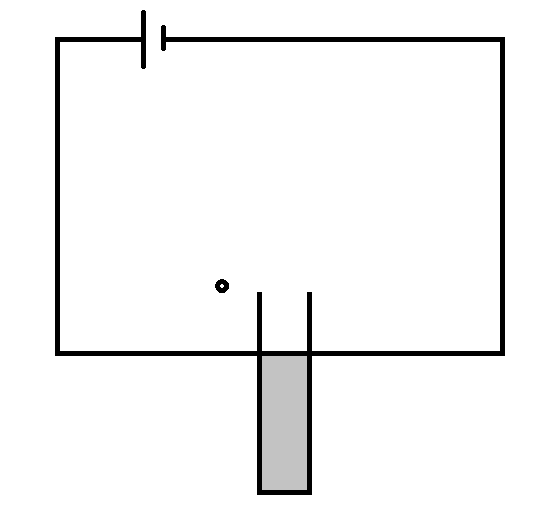
A dielectric slab of dielectric constant


Answer
472.2k+ views
Hint: We will first evaluate the new capacitance after the dielectric is inserted in it. Then using that capacitance we will evaluate the electrostatic pull due to the battery and using these parameters and given quantities we will evaluate the time the slab falls off when some mass is introduced without any impulse.
Formula used:
The formula of the capacitance
Electrostatic potential energy formula
Electrostatic force
Complete step by step solution:
Suppose at any point
Hence the new capacitance will be given as
where
Now using this dielectric we will evaluate the potential energy which can be given by
Substituting the value of capacitance from the equation
We know that the electrostatic pull is acting due to battery of voltage
Hence differentiating the equation
Also given that this electrostatic force equals to gravity acting on the dielectric which results as
Hence on comparing it
Now the Net force
Hence the acceleration can be given as
Form equation
Substituting it in the equation
Now the slab is half-filled with dielectric hence the height of the dielectric
Now evaluating the time by the formula for
Hence the time the slab falls off when some mass is introduced without any impulse is
Note:
Dielectric is a material that is insulating. In other words it is a very poor conductor of electricity. When we place dielectrics in the electric fields, then current flows through them practically as they don’t have free electrons and loose bounds.
Formula used:
The formula of the capacitance
Electrostatic potential energy formula
Electrostatic force
Complete step by step solution:
Suppose at any point
Hence the new capacitance will be given as
where
Now using this dielectric we will evaluate the potential energy which can be given by
Substituting the value of capacitance from the equation
We know that the electrostatic pull is acting due to battery of voltage
Hence differentiating the equation
Also given that this electrostatic force equals to gravity acting on the dielectric which results as
Hence on comparing it
Now the Net force
Hence the acceleration can be given as
Form equation
Substituting it in the equation
Now the slab is half-filled with dielectric hence the height of the dielectric
Now evaluating the time by the formula for
Hence the time the slab falls off when some mass is introduced without any impulse is
Note:
Dielectric is a material that is insulating. In other words it is a very poor conductor of electricity. When we place dielectrics in the electric fields, then current flows through them practically as they don’t have free electrons and loose bounds.
Recently Updated Pages
Master Class 4 Maths: Engaging Questions & Answers for Success

Master Class 4 English: Engaging Questions & Answers for Success

Master Class 4 Science: Engaging Questions & Answers for Success

Class 4 Question and Answer - Your Ultimate Solutions Guide

Master Class 11 Economics: Engaging Questions & Answers for Success

Master Class 11 Business Studies: Engaging Questions & Answers for Success

Trending doubts
Give 10 examples of unisexual and bisexual flowers

Draw a labelled sketch of the human eye class 12 physics CBSE

a Tabulate the differences in the characteristics of class 12 chemistry CBSE

Differentiate between homogeneous and heterogeneous class 12 chemistry CBSE

Why is the cell called the structural and functional class 12 biology CBSE

Differentiate between insitu conservation and exsitu class 12 biology CBSE




